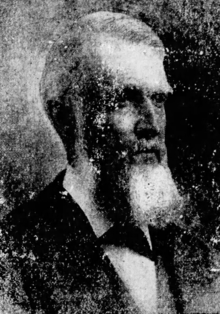This article needs additional citations for
verification. (October 2016) |
Lyman Belding | |
|---|---|
 | |
| Born | June 12, 1829 West Farms, Massachusetts |
| Died | November 22, 1917 (aged 88)
Stockton, California |
| Occupation | Ornithologist |
Lyman Belding (June 12, 1829 – November 22, 1917) was a prominent American ornithologist.
Biography
Lyman Belding was born to Joshua Belding and Rosetta Cooley Belding on June 12, 1829, at West Farms, Massachusetts, but later moved to Kingston, Pennsylvania when he was about 7 years old, and finally to California. He spent many years on whaling ships, but became fascinated by birds after acquiring his first bird book in 1876.
By then he retired in Stockton, California and became a foremost authority on the avifauna of California and Baja California. He died in Stockton on November 22, 1917, and is buried there in the Rural Cemetery. [1]
Legacy
Belding's yellowthroat (Geothlypis beldingi ) was named in his honor by Robert Ridgway.
Belding's orange-throated whiptail ( Aspidoscelis hyperythrus beldingi), a subspecies of lizard, was named in his honour by Leonhard Stejneger. [2]
In addition to his work as a self-taught ornithologist, Belding made a contribution to Baja California anthropology. [3] In 1882–1883, he joined with the Dutch anthropologist Herman ten Kate in exploring the Cape Region at the peninsula's southern extremity. In 1885, Belding published an article describing their largely unsuccessful efforts at locating descendants of the region's native Pericú inhabitants and their more successful discoveries of caves containing distinctive secondary, painted burials. [4]
References
- ^ "Aged Ornithologist Dead". The Sacramento Bee. Stockton. November 23, 1917. p. 7. Retrieved January 21, 2020 – via Newspapers.com.
- ^ Beolens, Bo; Watkins, Michael; Grayson, Michael (2011). The Eponym Dictionary of Reptiles. Baltimore: Johns Hopkins University Press. xiii + 296 pp. ISBN 978-1-4214-0135-5. ("Belding", p. 22).
- ^ Laylander, Don (2014). "The Beginnings of Prehistoric Archaeology in Baja California, 1732-1913." Pacific Coast Archaeological Society Quarterly 50(1&2):1-31
- ^ ""The Pericue Indians." West-American Scientist 1(4):21-22". Archived from the original on April 2, 2015. Retrieved March 24, 2015.
External links
This article needs additional citations for
verification. (October 2016) |
Lyman Belding | |
|---|---|
 | |
| Born | June 12, 1829 West Farms, Massachusetts |
| Died | November 22, 1917 (aged 88)
Stockton, California |
| Occupation | Ornithologist |
Lyman Belding (June 12, 1829 – November 22, 1917) was a prominent American ornithologist.
Biography
Lyman Belding was born to Joshua Belding and Rosetta Cooley Belding on June 12, 1829, at West Farms, Massachusetts, but later moved to Kingston, Pennsylvania when he was about 7 years old, and finally to California. He spent many years on whaling ships, but became fascinated by birds after acquiring his first bird book in 1876.
By then he retired in Stockton, California and became a foremost authority on the avifauna of California and Baja California. He died in Stockton on November 22, 1917, and is buried there in the Rural Cemetery. [1]
Legacy
Belding's yellowthroat (Geothlypis beldingi ) was named in his honor by Robert Ridgway.
Belding's orange-throated whiptail ( Aspidoscelis hyperythrus beldingi), a subspecies of lizard, was named in his honour by Leonhard Stejneger. [2]
In addition to his work as a self-taught ornithologist, Belding made a contribution to Baja California anthropology. [3] In 1882–1883, he joined with the Dutch anthropologist Herman ten Kate in exploring the Cape Region at the peninsula's southern extremity. In 1885, Belding published an article describing their largely unsuccessful efforts at locating descendants of the region's native Pericú inhabitants and their more successful discoveries of caves containing distinctive secondary, painted burials. [4]
References
- ^ "Aged Ornithologist Dead". The Sacramento Bee. Stockton. November 23, 1917. p. 7. Retrieved January 21, 2020 – via Newspapers.com.
- ^ Beolens, Bo; Watkins, Michael; Grayson, Michael (2011). The Eponym Dictionary of Reptiles. Baltimore: Johns Hopkins University Press. xiii + 296 pp. ISBN 978-1-4214-0135-5. ("Belding", p. 22).
- ^ Laylander, Don (2014). "The Beginnings of Prehistoric Archaeology in Baja California, 1732-1913." Pacific Coast Archaeological Society Quarterly 50(1&2):1-31
- ^ ""The Pericue Indians." West-American Scientist 1(4):21-22". Archived from the original on April 2, 2015. Retrieved March 24, 2015.
External links